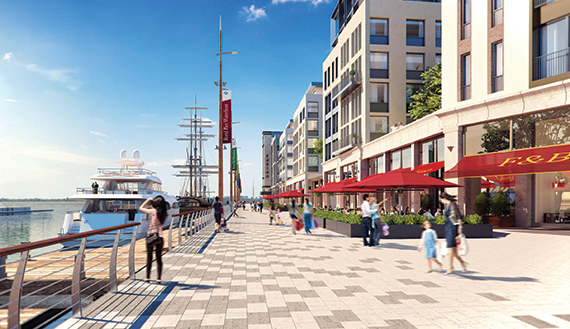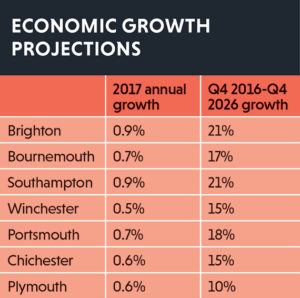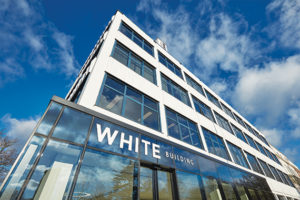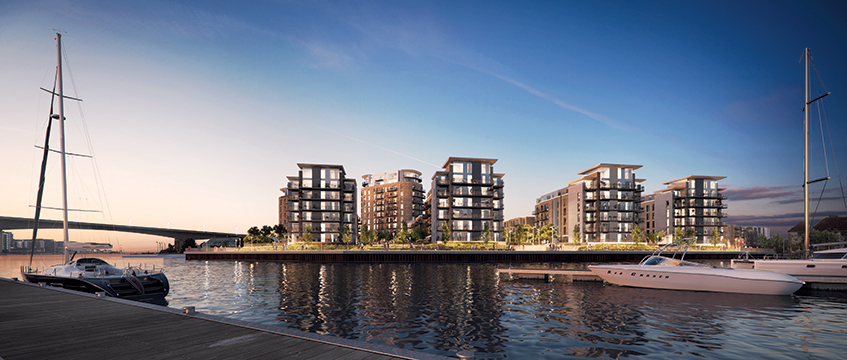Not unlike the cruise ships that glide in and out of its waterfront, Southampton has steered itself towards a strong economic future.
Dawn Baxendale, chief executive officer of Southampton City Council, says £1.6bn worth of investment to date has been “actually built, is cranes in the sky or is all the way through planning” over most of the last decade. And, she adds: “It’s a really big turnaround.”
Research by Irwin Mitchell/Cebr paints a favourable picture for Southampton’s economic prospects amongst South Coast counterparts with a 10-year growth projection of 21% and job expansion predicted to be above the national average in 2017.
New projects are poised to move forward under the next phase of the city’s masterplan, which identifies several VIP sites – most notably the 52-acre mixed-use Royal Pier Waterfront, where between 100,000 sq ft and 500,000 sq ft of offices could be built. There are also ambitions to bring forward a new 136-acre central business district stretching from the main railway station to West Quay. Baxendale says discussions with investors are continuing to address “the art of the possible” for the latter.

Nella Pang, associate director at JLL and chair of the Southampton Property Association, considers the addition of such space to be a vital ingredient for the city’s future. “We are at a very exciting stage. There is a lot to shout about.” That includes the city’s economy, which has a diverse business base and capitalises heavily on its port – one of the most productive in Europe. Maritime, freight handling and shipping companies are “well represented” says Martin Hastelow, head of Savills’ Southampton office, as is the cruise industry. But so too, he says, are accountants, professional sectors and banks, along with success stories amongst creative start-ups at the science park. Two renowned universities are also key drivers.
Some, however, believe more could still be done to attract new businesses. Research by CBRE shows 2016 office take-up was above the long-term average. But, says south central region managing director James Brounger, this involves existing space and there is still no prelet activity.
“Southampton is one of the best value locations in the country. That’s appealing to occupiers and we should make more of that. We need to extol the virtues of the city – its leisure and transport. The city council has done a good job of promoting improved amenities but from an office perspective, we need to promote this more to wider business.”
Robin Shepherd, partner of planning consultancy Barton Willmore, says the city should also be leveraging more from its marine strengths, including benefits from the leisure sector. Only now is the city seeing its first five star hotel development – the Harbour Hotel & Spa at Ocean Village.
“How can we capture more of that?” he asks. “Then there’s the waterfront. If Royal Pier happens, it will be a fantastic thing, but there is a huge amount of waterfront and it offers massive potential.”
 Savills’ head of south coast development Colin Wilkins agrees Royal Pier will be “absolutely fascinating” but believes there are already early signs of development opening up the waterside including Inland Homes’ Meridian Waterside, which will include around 53,000 sq ft of commercial and office space. The future of the M27 corridor report by Savills says such residential-led, mixed-use schemes could hold the key to bringing forward badly needed new office space.
Savills’ head of south coast development Colin Wilkins agrees Royal Pier will be “absolutely fascinating” but believes there are already early signs of development opening up the waterside including Inland Homes’ Meridian Waterside, which will include around 53,000 sq ft of commercial and office space. The future of the M27 corridor report by Savills says such residential-led, mixed-use schemes could hold the key to bringing forward badly needed new office space.
So too, it says, could refurbishments, which have started to drip-feed the space that will help Southampton to cater for the needs of modern businesses, including agile working space and networking environments. Forelle Estates has just undertaken a comprehensive refurbishment of Savannah House in Ocean Village and CBRE’s Brounger – his firm now joining PwC and Vail Williams as occupiers there – says: “In Southampton, it’s as close to new build as you will get.” Forelle’s managing director Mike Price, adds: “It was a case of right building, right time – let’s do it.”
Serviced office accommodation is also surfacing and Regus now has its first city centre operation – another example of refurbishment. It’s 20,000 sq ft centre in Cumberland House opened last year and has occupancy levels ahead of plan, says UK chief executive Richard Morris, who adds: “In a city the size of Southampton, we would have no problem with having more than one offer in the centre.”
That will certainly be music to the ears of regional agents like Hughes Ellard director Russell Mogridge, who says the city had been starved of such space.
Flexible office space at The White Building
 The White Building in Cumberland Place was launched by the Ashville Group in early 2016, and is now 75% let.
The White Building in Cumberland Place was launched by the Ashville Group in early 2016, and is now 75% let.
One of its agents, Nella Pang, associate director at JLL, says: “It is answering the trends we are witnessing in the market. With the economy being quite volatile, a lot of organisations are looking for flexible space.”
Ashville’s redevelopment included the creation of breakout areas and collaborative working spaces in the main reception and – also much in demand – the provision of bicycle parking and maintenance facilities and staff showers.
Occupiers can lease individual workstations in ground floor studio space within a serviced office element or a range of floorplates throughout the building. These are also designed to appeal to a variety of company cultures –more traditional fitouts with carpets and suspended ceilings or wooden floorings, solid ceilings with LED lighting and an ‘engineering’ feel – more likely to appeal, says Pang, to technology companies who “want more funky space”.











